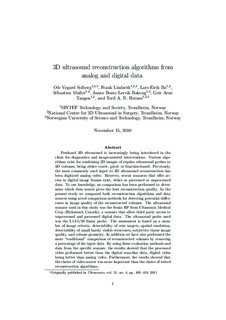| dc.contributor.author | Solberg, Ole Vegard | |
| dc.contributor.author | Lindseth, Frank | |
| dc.contributor.author | Bø, Lars Eirik | |
| dc.contributor.author | Muller, Sebastien | |
| dc.contributor.author | Meland, Janne Beate Lervik | |
| dc.contributor.author | Tangen, Geir Arne | |
| dc.contributor.author | Hernes, Toril A. Nagelhus | |
| dc.date.accessioned | 2018-09-18T09:01:31Z | |
| dc.date.available | 2018-09-18T09:01:31Z | |
| dc.date.created | 2011-06-29T09:34:55Z | |
| dc.date.issued | 2010 | |
| dc.identifier.citation | Ultrasonics. 2011, 51 (4), 405-419. | nb_NO |
| dc.identifier.issn | 0041-624X | |
| dc.identifier.uri | http://hdl.handle.net/11250/2563117 | |
| dc.description.abstract | Freehand 3D ultrasound is increasingly being introduced in the clinic for diagnostics and image-assisted interventions. Various algorithms exist for combining 2D images of regular ultrasound probes to 3D volumes, being either voxel-, pixel- or function-based. Previously, the most commonly used input to 3D ultrasound reconstruction has been digitized analog video. However, recent scanners that offer access to digital image frames exist, either as processed or unprocessed data. To our knowledge, no comparison has been performed to determine which data source gives the best reconstruction quality. In the present study we compared both reconstruction algorithms and data sources using novel comparison methods for detecting potential differences in image quality of the reconstructed volumes. The ultrasound scanner used in this study was the Sonix RP from Ultrasonix Medical Corp (Richmond, Canada), a scanner that allow third party access to unprocessed and processed digital data. The ultrasound probe used was the L14-5/38 linear probe. The assessment is based on a number of image criteria: detectability of wire targets, spatial resolution, detectability of small barely visible structures, subjective tissue image quality, and volume geometry. In addition we have also performed the more “traditional” comparison of reconstructed volumes by removing a percentage of the input data. By using these evaluation methods and data from the specific scanner, the results showed that the processed video performed better than the digital scan-line data, digital video being better than analog video. Furthermore, the results showed that the choice of video source was more important than the choice of tested reconstruction algorithms. | nb_NO |
| dc.language.iso | eng | nb_NO |
| dc.publisher | Elsevier | nb_NO |
| dc.rights | Attribution-NonCommercial-NoDerivatives 4.0 Internasjonal | * |
| dc.rights.uri | http://creativecommons.org/licenses/by-nc-nd/4.0/deed.no | * |
| dc.title | 3D ultrasound reconstruction algorithms from analog and digital data | nb_NO |
| dc.type | Journal article | nb_NO |
| dc.type | Peer reviewed | nb_NO |
| dc.description.version | acceptedVersion | nb_NO |
| dc.source.pagenumber | 405-419 | nb_NO |
| dc.source.volume | 51 | nb_NO |
| dc.source.journal | Ultrasonics | nb_NO |
| dc.source.issue | 4 | nb_NO |
| dc.identifier.doi | 10.1016/j.ultras.2010.11.007 | |
| dc.identifier.cristin | 827522 | |
| dc.description.localcode | © 2010. This is the authors’ accepted and refereed manuscript to the article. This manuscript version is made available under the CC-BY-NC-ND 4.0 license http://creativecommons.org/licenses/by-nc-nd/4.0/ | nb_NO |
| cristin.unitcode | 194,65,25,0 | |
| cristin.unitcode | 194,63,10,0 | |
| cristin.unitname | Institutt for sirkulasjon og bildediagnostikk | |
| cristin.unitname | Institutt for datateknologi og informatikk | |
| cristin.ispublished | true | |
| cristin.fulltext | postprint | |
| cristin.qualitycode | 1 | |

